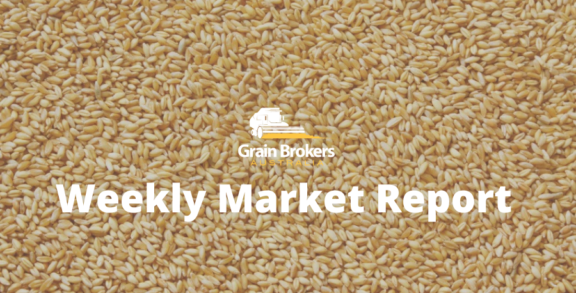With this season’s winter and spring crop harvest across the European Union largely concluded and the summer crop harvest now underway in the bloc’s southern growing regions, the total grain production expectations for the 2024/25 season have continued to decline as final harvested yields are gradually revealed.
This reduction can primarily be attributed to adverse weather conditions, particularly record rainfall in late 2023 and then a wet harvest, which negatively impacted winter crop sowing and plant development across key producing countries such as France, Germany, the Baltic states, and Poland. Dry weather in the Black Sea region also took the shine off mid-season winter crop production optimism in the neighbouring states of Bulgaria and Romania.
According to the European Commission’s latest production estimates released last Friday, total cereal production across this season’s winter, spring and summer cropping programs is projected at 260.9 million metric tonne, down 3.3 per cent from 269.9MMT last season and 7.2 per cent lower than the five-year average of 281.1MMT. The total planted area of 49.6 million hectares was down from 50.3Mha last season and was one of the smallest this century.
Wheat occupies the most extensive area across the European Union’s 27 member states each season, with final plantings pegged at 22.6 million hectares compared to 23.9Mha a season earlier and the five-year average of 23.8Mha. The soft wheat area of 20.4Mha was 6.1 per cent lower than the 2023 area, but the durum wheat area only fell by 1.1 per cent season-on-season to 2.1Mha.
The EC has pegged wheat production at 121.8MMT, down from 132.5MMT in 2023/24 and the five-year average of 134.2MMT, making it one of the worst EU harvests in the past 40 years. The soft wheat component of that total is 114.6MMT, down from 125.5MMT last season and the five-year average of 126.8MMT, while the durum wheat harvest is small in comparison at 7.2MMT, up from 7.0MMT in 2023 but lower than the five-year average of 7.4MMT.
The European wheat harvest faced significant quality challenges due to the varied and hostile weather conditions experienced across some of the continent’s key growing areas over the harvest period. The unseasonably wet conditions caused delays in harvesting and adversely affected crop development in western Europe, whilst grain fill in parts of central and eastern Europe suffered from a lack of moisture in the latter part of the season.
These wet weather conditions led to significant wheat quality issues, with lower-than-normal protein levels and test weights reported. The French crop was the hardest hit, with the government farm institute FranceAgriMer stating that only 28 per cent of this year’s crop exceeded the minimum milling quality test weight threshold of 76 kilograms per hectolitre. Kernal weight determines the amount of flour that can be extracted in the manufacturing process, with millers expecting to grind five to six per cent more wheat than usual to produce the equivalent amount of flour.
However, with French milling wheat a highly sought commodity by the global consumer, it is exports that are expected to suffer the most in the 2024/25 marketing year. According to FranceAgriMer, shipments of French wheat outside the EU could plummet by more than 60 per cent compared to 2023/24 due to the poor quality profile, with other member states such as Germany, Poland and the Baltic states hoping to fill some of the void.
Barley is traditionally the second biggest cereal crop by area in the EU-27 every year. This was again the case in 2024, with a harvested area of 10.4Mha compared to 10.3Mha in 2023 and an average of 10.6Mha across the previous five seasons. Contrary to wheat, the barley output projection has increased year-on-year from 47.5MMT to 50.4MMT but still sits slightly below the five-year average of 51.9MMT.
The main oilseed grown across the EU-27 trading bloc each season is rapeseed – they refuse to call it canola in Europe. The EC is calling the harvested area 5.8Mha, down 7.3 per cent from 6.2Mha in 2023 but above the 5.6Mha average since 2019. However, the production fall was far more dramatic, down 12.7 per cent year-on-year to 17.2MMT. Following big crops in each of the past two years, the 2024 output fell 2.7 per cent below the five-year mean of 17.7MMT.
On the summer crop front, favourable weather conditions have prevailed in western parts of Europe, but a rainfall deficit and very high temperatures in most of southern-central and eastern Europe have negatively impacted biomass accumulation and shortened the corn grain-filling period. Severe flooding in September due to a weather system known as Storm Boris adversely affected crop development in central European states, in particular Germany. The yield outlook is particularly poor in Bulgaria and Romania, where extremely dry conditions have prevailed since late spring, while the French and Polish output forecasts are higher than in 2023.
The EU-27’s second biggest cereal crop by production each season is corn. Although the planted area is traditionally less than barley, being the most efficient of the modern cereal grains for conversion of water and carbon dioxide into carbohydrates, the average corn yield is more than 50 per cent higher. This year’s planted area of 8.8Mha is significantly higher than last year’s 8.4Mha, but it is still slightly lower than the 8.9Mha average since 2019. However, production has suffered, with the European Commission’s September yield forecast coming in 2.7 per cent lower than the August estimate. This year’s EU-27 harvest is currently expected to total 60.1MMT, down 4.1 per cent compared to 62.7MMT in 2023 and 7.9 per cent below the five-year average of 65.3MMT.
As the summer crop harvest gains momentum across the EU, the majority of farmers across the European continent will very quickly and unceremoniously commit memories of the 2024/25 season to the trash bin and look forward to a more favourable season ahead. However, the winter crop planting campaign is already facing headwinds, particularly with the persistent dry conditions across eastern Europe.
Call your local Grain Brokers Australia representative on 1300 946 544 to discuss your grain marketing needs.
Written by Peter McMeekin.





